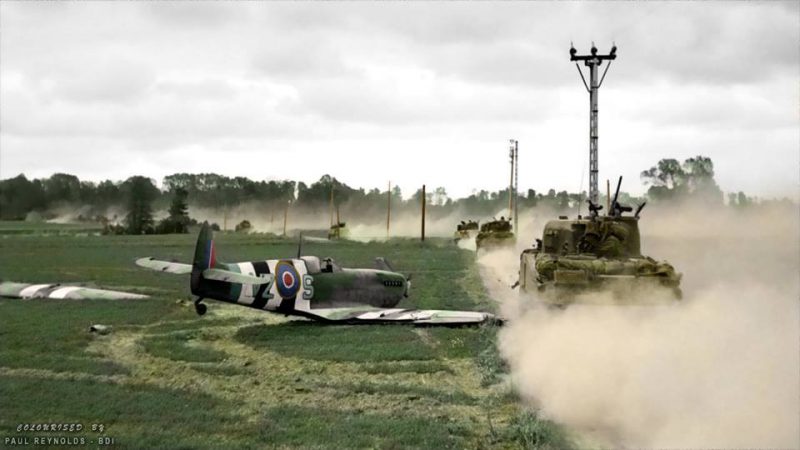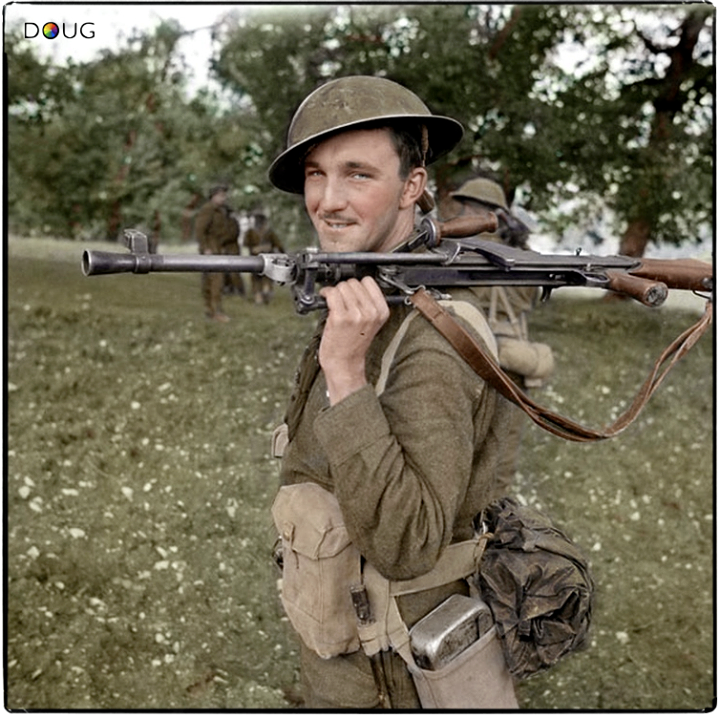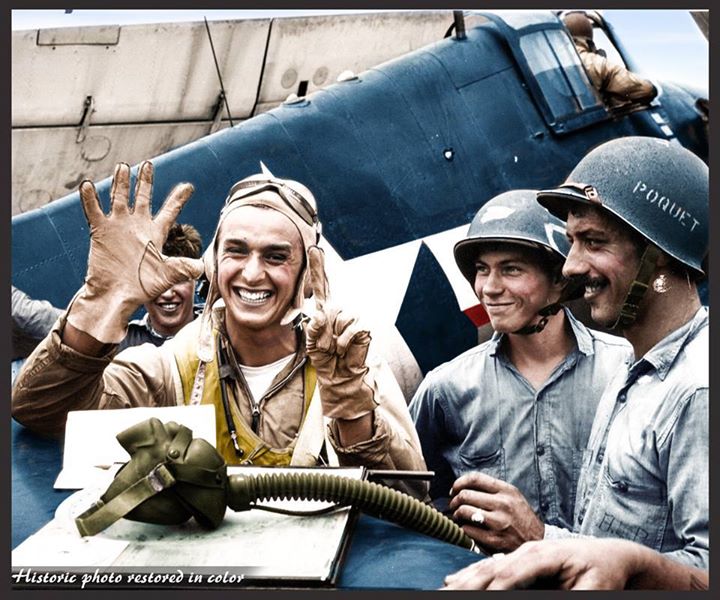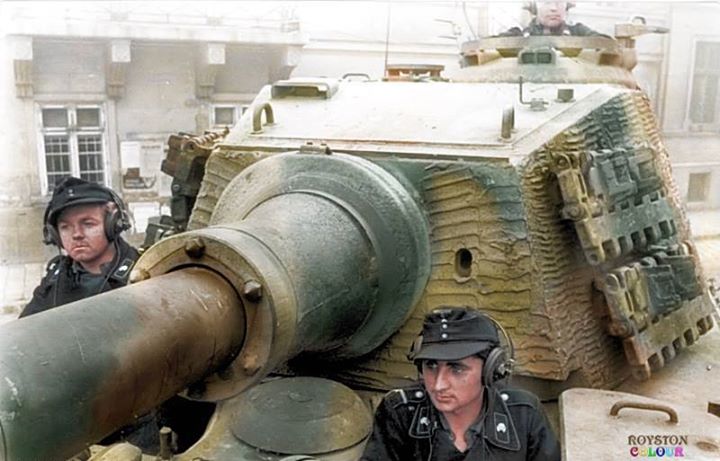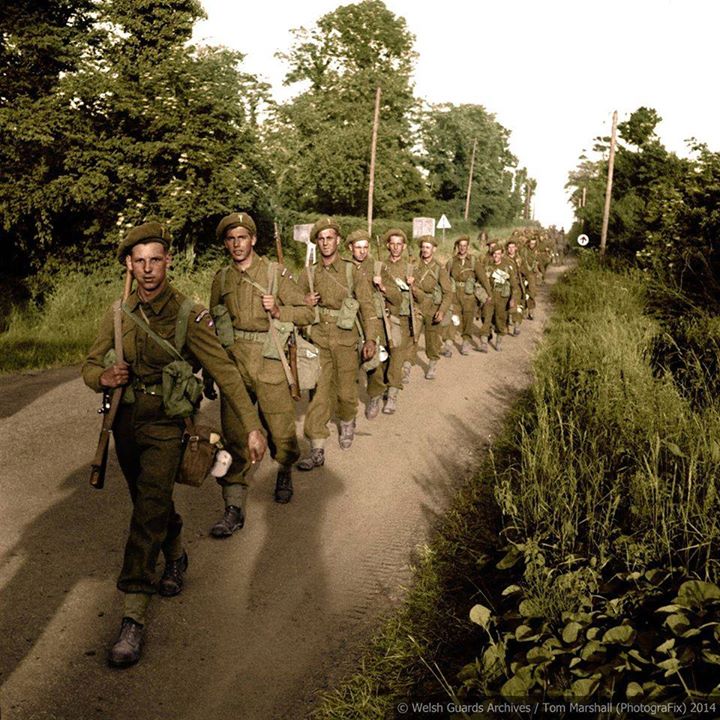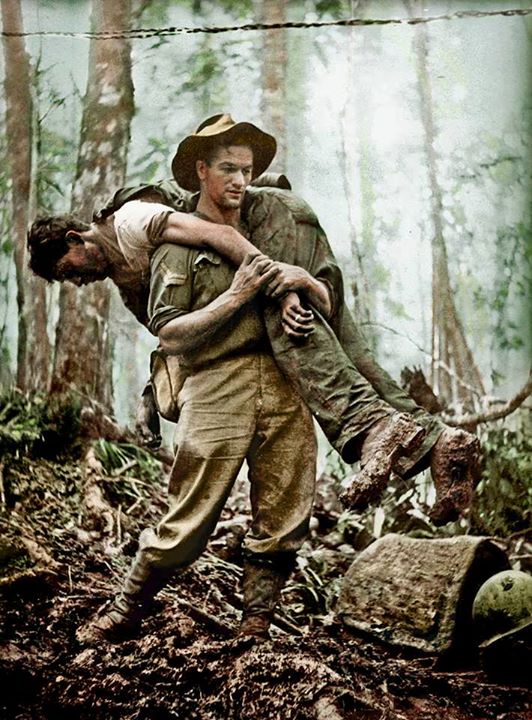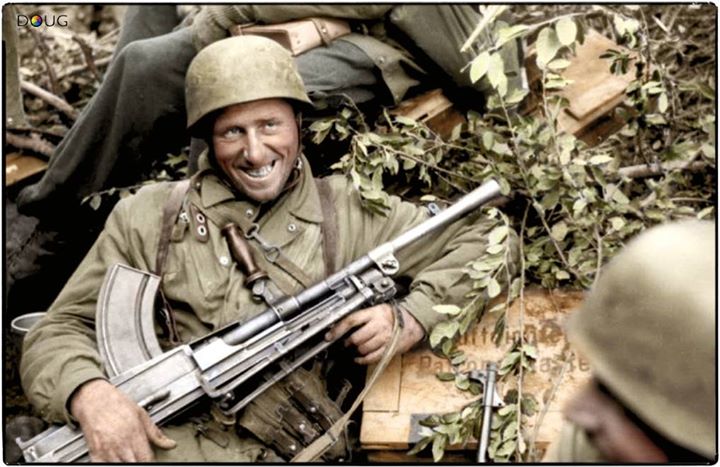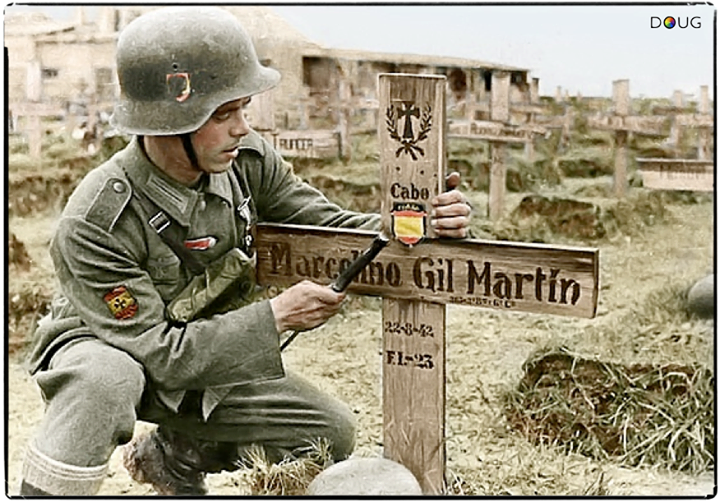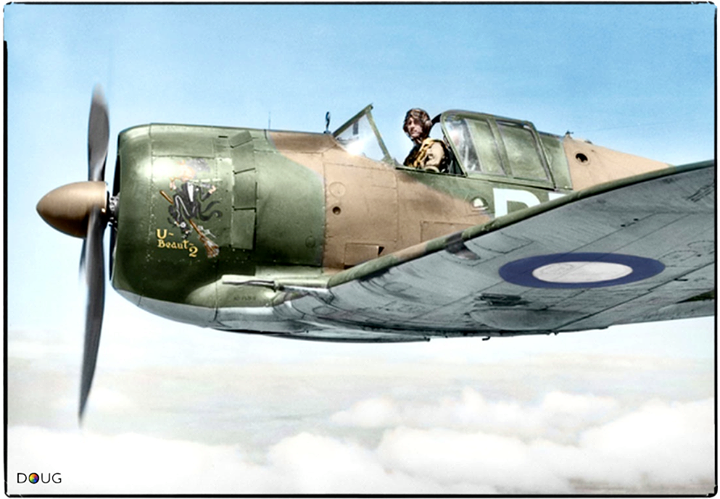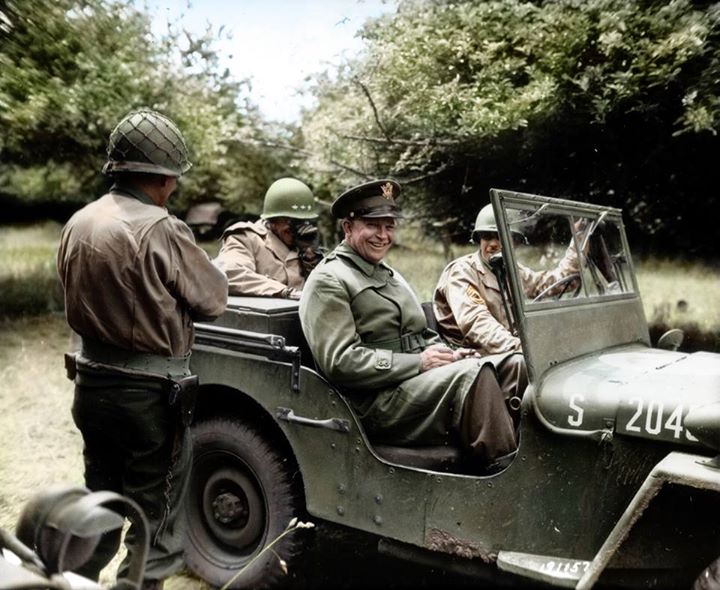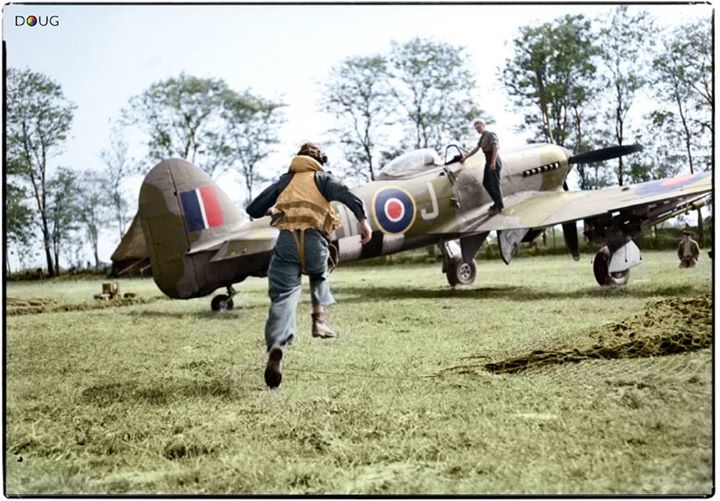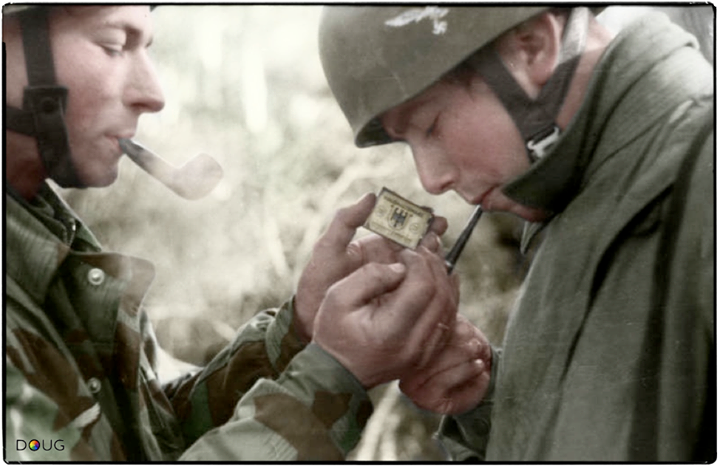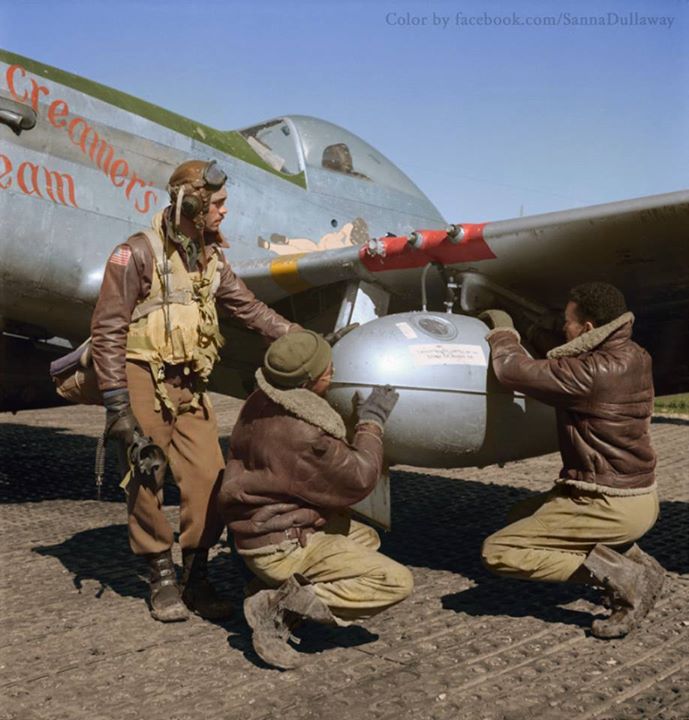Many thanks go to Doug Banks and his team – the masters of colourisation. The beauty of these colourised images is that colour, allows you to pick out and study the smallest detail. Do not click on their page – you will become addicted to their work It is the research that they do on each image that makes the captions themselves a history lesson. Facebook page here Colourised-Photos
Private D.B.MacDonald, Royal Canadian Regiment (1CID) Campobasso, Italy, 11-14th of October 1943.
(LAC, PA163412)
The Bren Gun is a MkII with the sling mounted on the forward tripod fitting. The gun’s bipod is the late-model, unadjustable version.
Alex Vraciu, who was just 25 when he reigned as the US Navy’s top World War II fighter ace after downing 19 Japanese aircraft and destroying 21 more on the ground in only eight months in 1944, died on January the 29th 2015 in West Sacramento, Calif. He was 96.
Alex Vraciu accomplished his most spectacular feat in the South Pacific when he shot down six dive bombers within eight minutes in what became known as the “Great Marianas Turkey Shoot” in the Philippine Sea. He called it “a once-in-a-lifetime fighter pilot’s dream.”
Two of the aircraft carriers he flew from were torpedoed, twice he parachuted to safety, and twice more he was forced to ditch his Grumman F6F Hellcat — brushes with death that earned him the nicknames Grumman’s Best Customer and The Indestructible.
He was nominated for the Medal of Honor and received the service’s second-highest honor, the Navy Cross. And although he ranked as the Navy’s top ace for four months, he ended the war in fourth place. When he died, he was the nation’s ranking living World War II ace, according to the American Fighter Aces Association.
He was born on Nov. 2, 1918, in East Chicago, Ind., the son of Romanian immigrants. Shortly after graduating from DePauw University in Greencastle, Ind., already armed with a civilian pilot’s license, he enlisted in a Navy flight training program six months before the Japanese attacked Pearl Harbor.
He entered combat in 1943 as part of Fighting Squadron 6, serving as wingman for Lt. Cmdr. Butch O’Hare, the Navy’s first combat pilot ace and its first aviator to receive the Medal of Honor in World War II.
Alex Vraciu achieved his pace-setting six kills under harrowing conditions on June 19, 1944, as Japanese planes attacked a task force of American carriers and battleships. His plane’s folding wings were mistakenly unlocked, and a malfunctioning engine was spewing oil on his windshield and preventing him from climbing above 20,000 feet. Still, he downed the dive bombers firing only 360 of the 2,400 bullets in his arsenal.
After the war, he worked for the Navy as a test pilot and commanded a fighter squadron. He retired in 1964 with the rank of commander and joined Wells Fargo Bank as a trust officer.
(Colorised by Johhny Sirlande from Belgium) 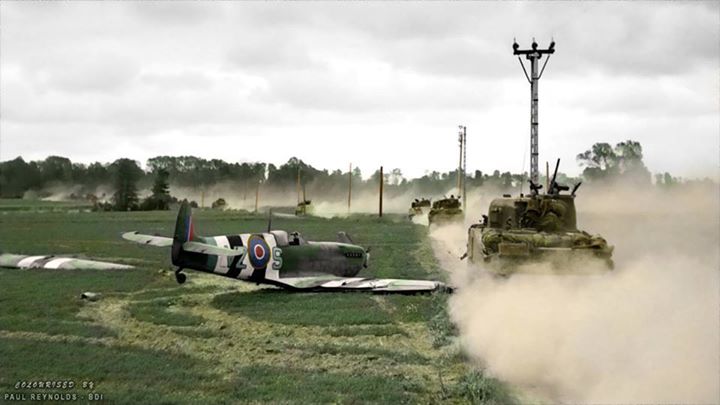
On the 11th of June 1944, F/O H.G. Garwood of 412 Squadron was flying VZ-S (MJ 255) MK IXc Spitfire when it suffered an engine failure* near Tilly-sur-Seulles, France, during the allied invasion. He was forced to execute a wheels-up landing which tore the port wing off as it looped in the grass. Fortunately Garwood was able to make it back to his base unharmed.
We think these tanks maybe from the 24th Lancers with the 8th Armoured Brigade, the regiment landed on Gold Beach, in the second wave of the Operation Overlord landings, supporting the 50th (Northumbrian) Infantry Division. Shortly after landing, it was involved in the fighting around Putot-en-Bessin and Villers Bocage, also seeing intensive action in the Tilly-sur-Seulles, Fontenay-le-Pesnel, Tessel Wood and Rauray areas.
Photo taken on the 17th of June as these Shermans were advancing.
*Note: Most reports say he suffered engine failure though a few articles say this spit was shot down by enemy AA, if anyone knows for certain please let me know.
(Colourised and Researched by Paul Reynolds.)
https://www.facebook.com/PhotoColourisation
Historic Military Photo Colourisations)
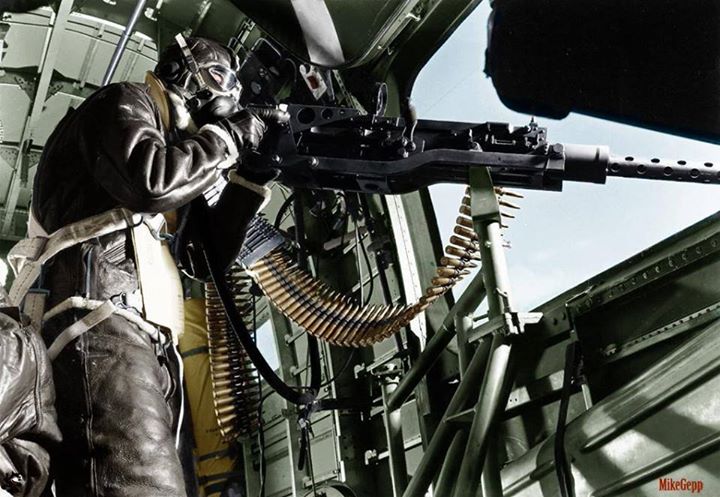
The Consolidated B-24 ‘Liberator’ waist gunner c.1944
Waist gunners were charged with the defence of the Liberator’s vulnerable sides through use of single 12.7mm machine guns. As such, these positions aboard Liberators suffered the most casualties by incoming fighters ready to strafe the large profile sides of the bomber. These two positions, left and right, were later staggered to compensate for each gunners firing arc.
Unlike other turreted positions in the B-24, spent shell casings at these waist positions were not jettisoned from the aircraft automatically, forcing crew-members to clear their areas themselves. Since firing from these side-perspective positions required a great deal of hand-to-eye coordination via tracer rounds while taking into account target speed and the Liberator’s airspeed itself, waist gunners relied on simple targeting sights in the early years. Only later did they receive assistance in the form of compensating sights to help improve accuracy.
(Colorised by Mike Gepp from Australia) 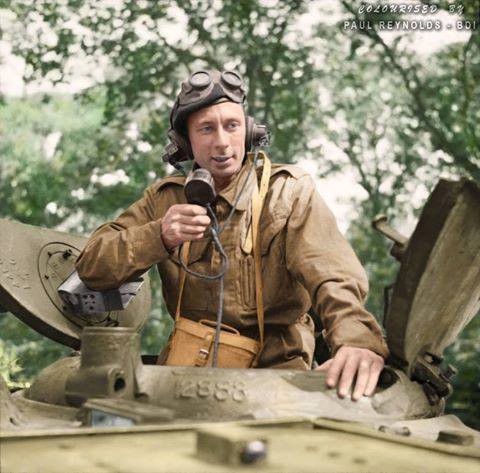
Sergeant A. Yorke of ‘C’ Squadron, 13th/18th Royal Hussars, 27th Armoured Brigade in the turret of his Sherman tank, during training, somewhere in the south of England.
30th of May 1944.
13/18 Hussars on D-Day were organised with:
RHQ – four Sherman tanks HQ Squadron – six Crusader AA Mark III (twin-20mm), 11 Stuart tanks and nine Humber scout cars A & B Squadron, each with four-tank troops and two in SHQ, plus two spare for a total of 20 C Squadron – four troops each with three Shermans and one Sherman 17-pdr and SHQ with four Shermans for a total of 20
(Source – © IWM [H 38968] – War Office official photographer
Sgt. J Mapham)
Colourised by Paul Reynolds.
https://www.facebook.com/PhotoColourisation
Historic Military Photo Colourisations)
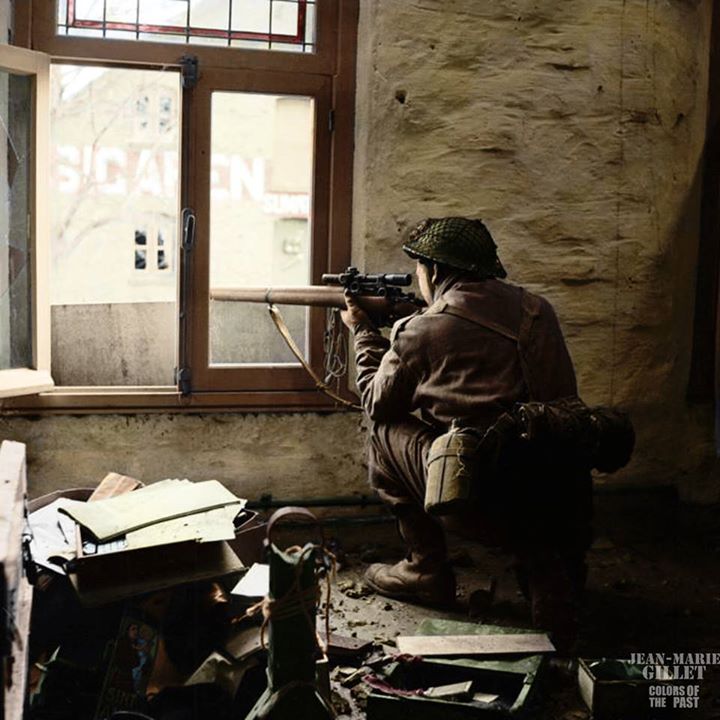
**This is a posed photo** taken after The Black Watch had entered Gennep on the 13th February 1945.
The Reichswald and Gennep
After the winter campaign in the Ardennes, the 51st Highland Division returned to Holland. The Battle for the Rhineland started on 8th February 1945. There was a sudden thaw and everywhere roads turned to mud. The Allies entered the Reichswald just across the Germany Border. The 5th Battalion The Black Watch was on the southern edge of the forest.
On the 11th of February the 5th Battalion The Black Watch was ordered south to take the Dutch town of Gennep on the river Niers. ‘B’ Company took the bridge, church and hospital. ‘C’ Company then got into the main street and took the right hand side of the town.
(Source – © IWM B 14628 – Sgt. Silverside, Nº 5 Army Film and Photographic Unit)
(Colourised by Jean-Marie Gillet from France)
https://www.facebook.com/colors.of.the.past?fref=ts
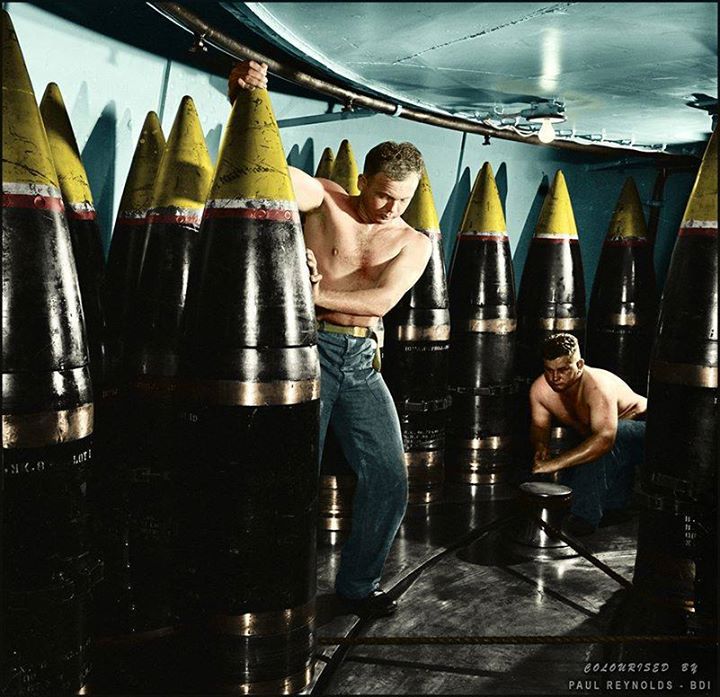
Nov 1944.
16″/50 calibre Mark 7 gun
These guns were 66.6 feet (20 m) long—50 times their 16-inch (406 mm) bore, or 50 calibres, from breech-face to muzzle. Each gun weighed about 239,000 pounds (108,000 kg) without the breech, or 267,900 pounds (121,517 kg) with the breech. They fired projectiles weighing from 1,900 to 2,700 pounds (850 to 1,200 kg) at a maximum speed of 2,690 feet per second (820 m/s) with a range of up to 24 miles (39 km). At maximum range the projectile spent almost 1½ minutes in flight. Each turret required a crew of 79 men to operate.
(Colourised and Researched by Paul Reynolds.)
https://www.facebook.com/
Historic Military Photo Colourisations)
Panzer VI ‘Tiger’ II Nº233 of sPz.Abt.503 sits near St. Georges Square, Budapest, Hungary during ‘Operation Panzerfaust’
15/16th of October 1944.
‘Operation Panzerfaust’, known as ‘Unternehmen Eisenfaust’ in Germany, was a military operation to keep the Kingdom of Hungary at Germany’s side in the war, conducted in October 1944 by the German military (Wehrmacht). When German dictator Adolf Hitlerreceived word that Hungary’s Regent, Admiral Miklós Horthy, was secretly negotiating his country’s surrender to the advancing Red Army, he sent commando leader Waffen-SS Lieutenant-Colonel Otto Skorzeny to Hungary. Hitler feared that Hungary’s surrender would expose his southern flank, where the Kingdom of Romania had just joined with the Soviets and cut off a million German troops still fighting the Soviet advance in the Balkan peninsula.
(Colourised by Royston Leonard from the UK)
https://www.facebook.com/pages/Colourized-pictures-of-the-world-wars-and-other-periods-in-time/182158581977012
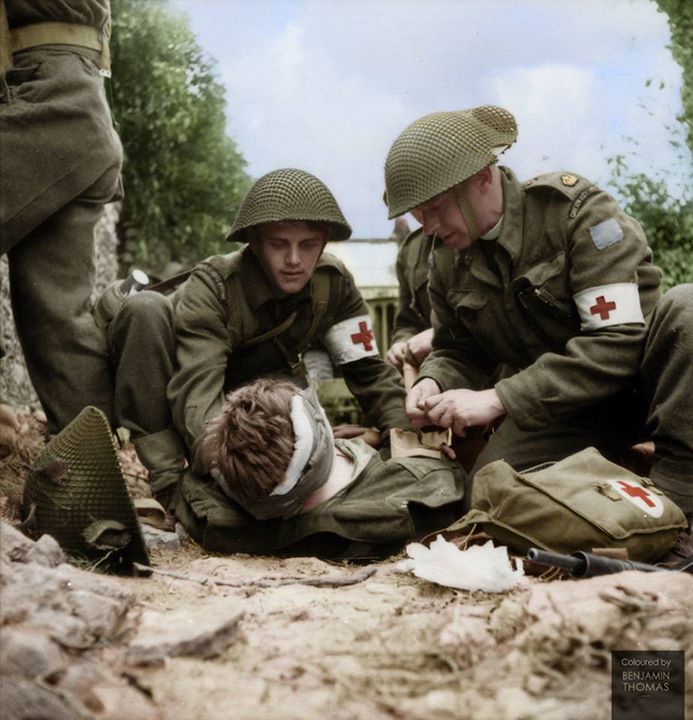
Major John W. Forth, Chaplain of The Cameron Highlanders of Ottawa (right), Canadian 3rd Infantry Division, helping the unit’s Regimental Aid Party treat a wounded comrade during the Battle of Caen, France, 15 July 1944.
Photographer: Lieut. H. Gordon Aikman
Image courtesy of Photos Normandie
https://www.flickr.com/
(Colourised and researched by Benjamin Thomas from Australia)
https://www.facebook.com/
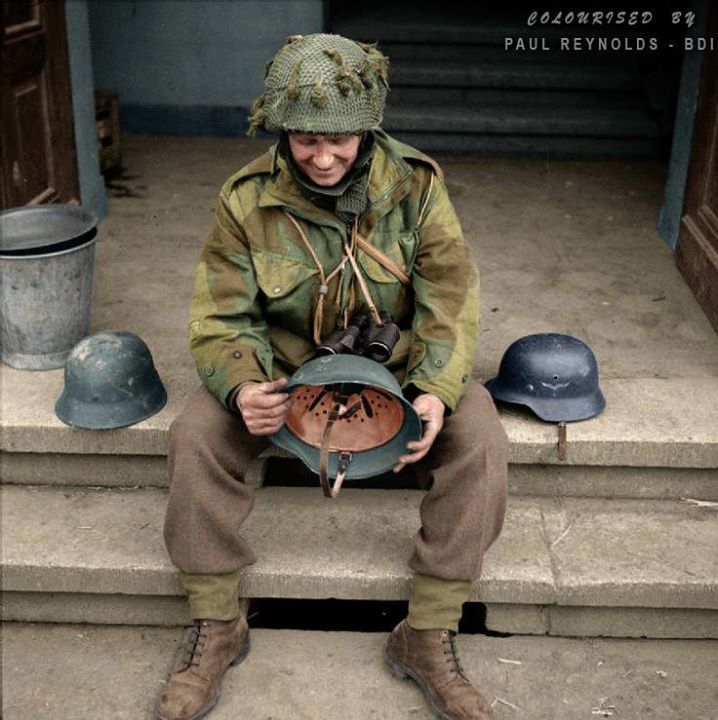
Regimental Sergeant Major Evans of the 12th Battalion, The Devonshire Regiment examines captured German helmets in Hamminkeln, Germany, 25th March 1945.
The airborne bridgehead operation over the Rhine – ‘Operation Varsity’.
The battalion deployed by glider on the 24th of March 1945 and succeeded in its task of capturing Hamminkeln with the loss of 140 men killed, wounded or missing.
The following day the battalion pushed out of the Rhine bridgehead with a troop of Churchill tanks and a troop of self-propelled anti-tank guns in support . The group encountered enemy forces after two miles and took 60 prisoners. Later that day they successfully secured the high ground overlooking Brunen but in doing so sustained a further 6 killed and 11 wounded.
On the 2nd of April the battalion was involved in heavy fighting securing Lengerich and suffered a further twelve killed and four wounded. However, in two days it captured over 100 Germans.
The battalion suffered a rare set back when ‘D’ and ‘B’ Companies crossed the River Weser on 6 April with no anti-tank guns or mortar support and encountered Panther tanks. In the resulting engagement 51 men of ‘D’ Coy were captured by the enemy. Generally, the boot remained on the other foot as the 6th Airborne continued its advance, and from 16 to 18 April the battalion captured over 150 enemy, as well as liberating Allied POWs and foreign farm labourers.
The battalion continued its advance to the Baltic coast, and the war diary notes that in the 41 days to 4 May, just under half of the 369 mile advance was travelled by the battalion on foot. It finished up at Hohen Viecheln on the Schweriner See about 10 miles south of Wismar.
(Source – © IWM BU 2301 – Sgt. Christie, No 5 Army Film & Photographic Unit
(Colourised by Paul Reynolds.
https://www.facebook.com/PhotoColourisation
Historic Military Photo Colourisations)
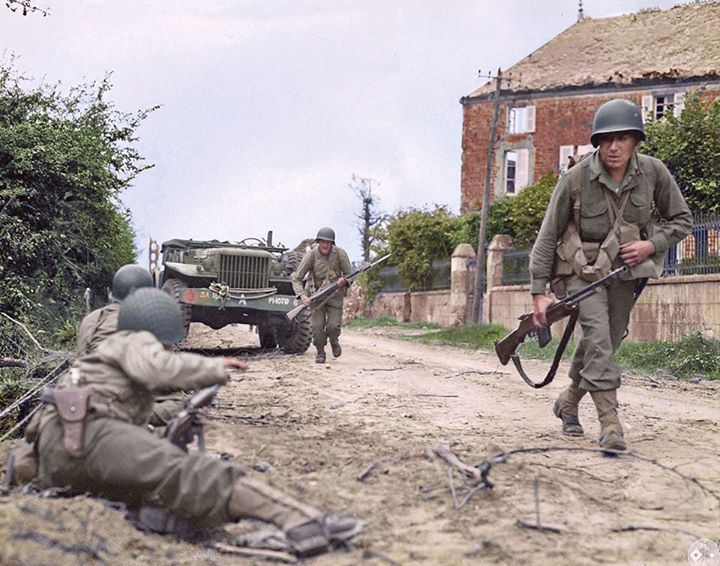
G.I.’s from (possibly) the 1st Btn, 314th Inf. Rgt. of the US 79th Inf. Div., during an attack on the Bolleville road, just north west of La Haye Du Puis in Normandy. c. 8th July 1944
The Dodge Command Car belongs to the 3rd A.D. 166th Signal Photo Co unit 6 and could be the transport of the photographer Rodger Hamilton.
The soldier on the right carries a .30 BAR Caliber Browning Automatic Rifle.
At 1830, on the 4th of July, 2nd Btn moved through 1st Btn’s position to bypass La Haye du Puits to reach an assembly area about 800 yards northwest of Bolleville. 1st Btn was holding the line to the right, and 3rd was in a defensive position northwest of Ste. Catherine. 5 July – After six hours of heavy fighting, 2nd Btn managed to only advance one-half mile and was stopped cold until tank support arrived. 3rd Btn’s K/Co was sent to recon La Haye du Puits and, at 0900, secured the railroad station on the north end of town. The Germans bombarded the station heavily and orders for K/Co to pull out were issued that afternoon. Later in the day, the entire 3rd Btn pulled back to regroup to the right flank (south of Bolleville) for the next day’s assault.
1st Btn moved in south from Bolleville. Late in the afternoon, 3rd Btn ran into a battalion of Waffen SS in defensive positions of La Haye du Puits. The 315th, near Montgarden, was so far away that what resulted was a 500 yard gap in the 3rd’s right flank. On the northern sector, a 1st Btn recon unit ran into resistance and had to fall back to Bolleville.
On the 7th of July, 2nd and 3rd Btn’s tried to advance again with slight progress and at a high casualty cost. By nightfall, command of 2nd Btn had changed three times due to heavy losses. 1st Btn made another attempt to reconnoiter La Haye du Puits, but ran into heavy German defensive positions – mine-studded fields strung with checkerboard patterns of piano wire about one inch off the ground, mortar bursts, and machine gun batteries. Behind the 314th’s position, the 8th Infantry Division was preparing it’s 28th Regiment to relieve 2nd Btn’s position. The next day’s orders were for the 1st Btn to just contain the town, leaving the dirty work to the 8th Infantry Division.
But, as will become pattern, the orders changed sending 1st into town. The battalion broke up into smaller units to penetrate the German defensive positions. It was an awkward, almost Guerilla-like attack, but after a day of this tactic, on 8 July, the 1st Btn secured La Haye du Puits.
(Source – US Army Signal Corps)
(Colourised by Allan White from Australia)
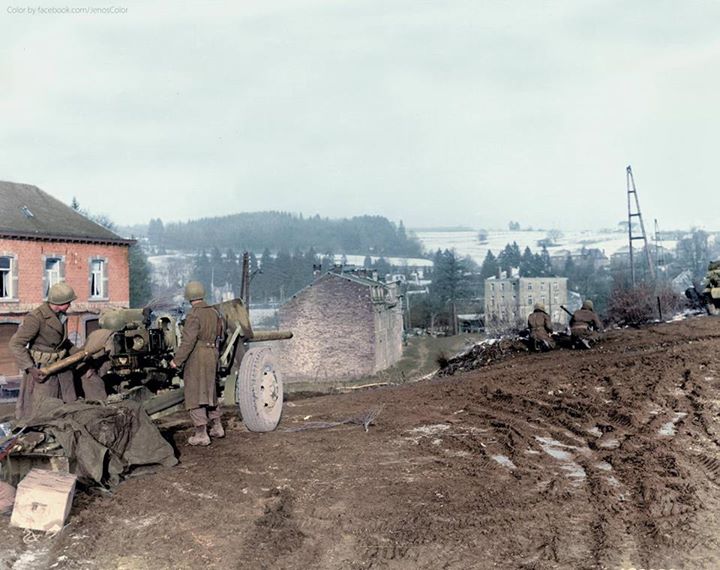
23rd of December 1944
The Battle of St. Vith was part of the Battle of the Bulge, which began on the 16th of December 1944, and represented the right flank in the advance of the German center, 5th Panzer-Armee, toward the ultimate objective of Antwerp.
“…….fortunately for the Americans, the weather came to their assistance for the first time in the campaign. What the Americans called a “Russian High” began blowing on the 23rd of December. A cold wind from the northeast, and clear weather, froze the ground, allowing the free movement of tracked vehicles and the use of allied air superiority. American forces were able to escape to the southwest, cross country to Crombach, Beho, Bovigny, and Vielsalm west of the Salm River. The Americans were able to outrun the panzers, and join forces with XVIII Airborne Corps by 24 December 1944”
(Colourised by Jared Enos from America)
https://www.facebook.com/JenosColor?fref=ts
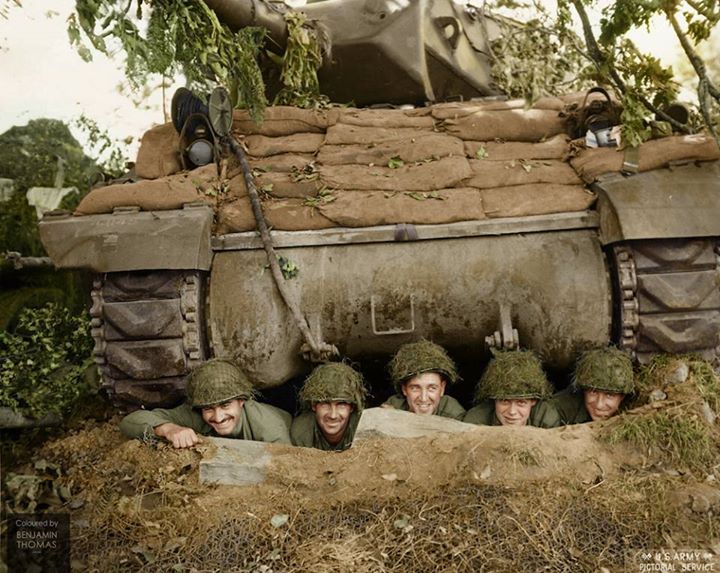
A US tank crew posing for the camera from a foxhole beneath their M-10 tank destroyer, north of Marigny, Normandy, 26 July 1944.
The men belong to the 703rd Tank Destroyer Battalion attached to Combat Command B of the 3rd Armored Division.
The unit landed in France on 1 July, and saw its first action near Hautes Vents a fortnight later. This photo was taken in the intervening week, before the unit participated in Operation Cobra – Lieutenant General Omar Bradley’s push to break through the German defensive lines that were pinning down Allied forces in the Normandy bocage countryside.
(Photographer: Roger Hamilton, US. Army Signal Corp)
(Colourised and researched by Benjamin Thomas from Australia)
https://www.facebook.com/coloursofyesterday
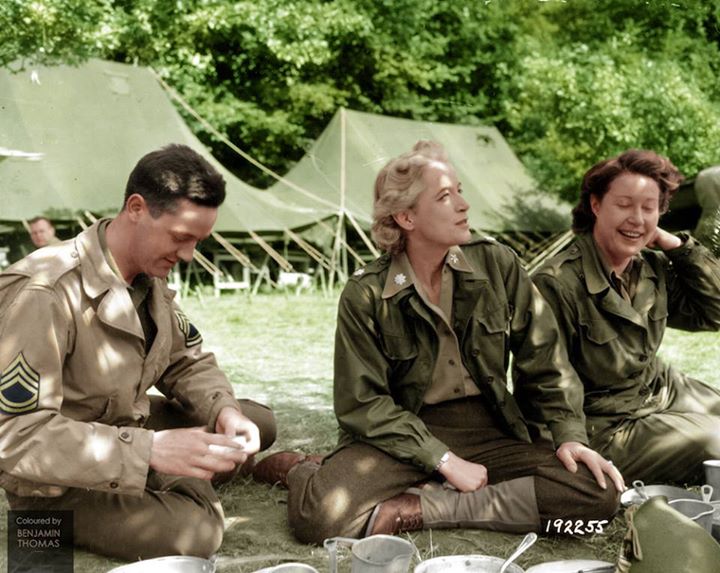
Lieutenant Colonel Anna “Tony” Walker Wilson, Women’s Army Corps (WAC) Staff Director in the European Theatre of Operations, sits in the shade of a tree with a fellow WAC and US Army Technical Sergeant, probably in the grounds of Château du Pont-Rilly, France, 1st of August 1944.
The WAC was the women’s branch of the United States Army, created first as an auxiliary unit in May 1942 (Women’s Army Auxiliary Corps, WAAC), before converting to full status as the WAC on 1 July 1943. It was disbanded in 1978 when it integrated with the male units.
Wilson arrived in England in April 1943 as WAC Staff Director, aged 34, and held that post until July 1945 when she was returned to Washington. She commanded 6,500 WACs in Europe, and in the course of her service received the Legion of Merit, the French Croix de Guerre and Legion of Honor, and the Order of the British Empire.
In January 1946, a year and a half after the photo was taken, she married Lloyd (or Loyd) Victor Steere, age 47, in Frankfurt, Germany.
Anna subsequently moved to Santa Monica, and died at the age of 89 in 1999.
(Image courtesy of Photos Normandie)
https://www.flickr.com/photos/photosnormandie
(Colourised and researched by Benjamin Thomas from Australia)
https://www.facebook.com/coloursofyesterday
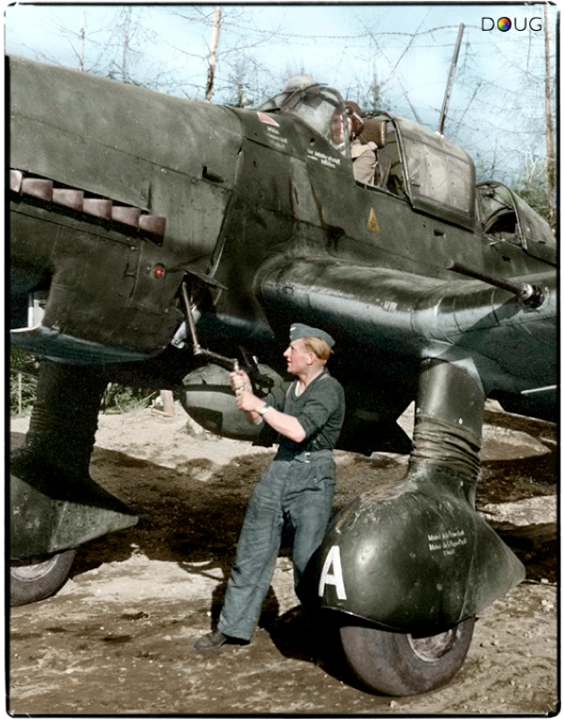
June/July 1944.
(Colourised by Doug)
The 1st Battalion Welsh Guards move forward, Normandy, July 1944.
This image is one of a series colourised by Tom Marshall at PhotograFix – Restored and Colourised Photos, for a new book by Trevor Royle on the history of the Welsh Guards 1915-2015.
‘Bearskins, Bayonets & Body Armour’ is available to purchase now from Pen and Sword Books at half price here; http://
For more info about the launch of the book last week at the Royal Hospital Chelsea, see The Army in London – HQ London District page.
Original image © Welsh Guards Archives.
Colourised image © Welsh Guards Archives / Tom Marshall 2014. All rights reserved.
(Colourised by Tom Marshall from the UK)
http://www.facebook.com/
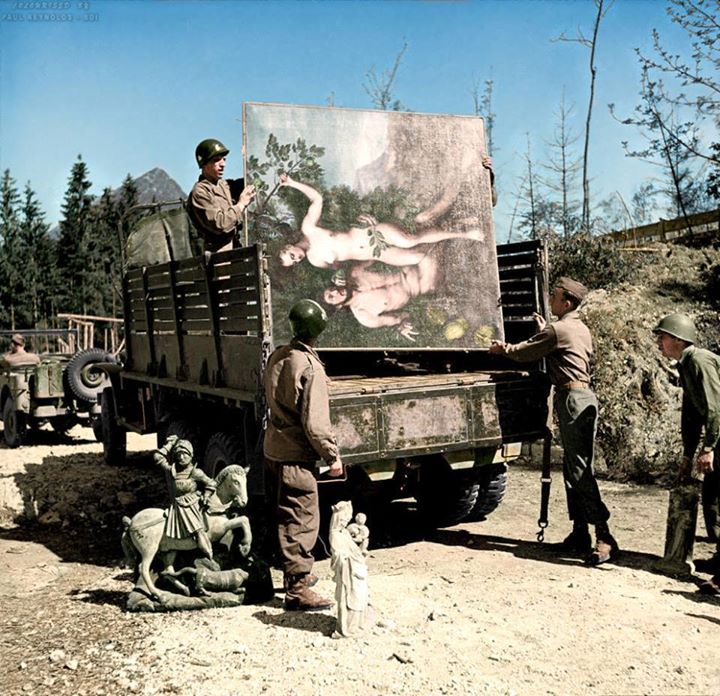
U.S. soldiers of the 101st Airborne Division carry wooden sculptures and paintings, including the “Adam and Eve” oil painting by Franz Floris from 1550, out of Hermann Goering’s art bunker in the Wemholz, Berchtesgaden area, and load them into a truck. May 1945
(Colourisation and Research by Paul Reynolds.)
https://www.facebook.com/
Historic Military Photo Colourisations
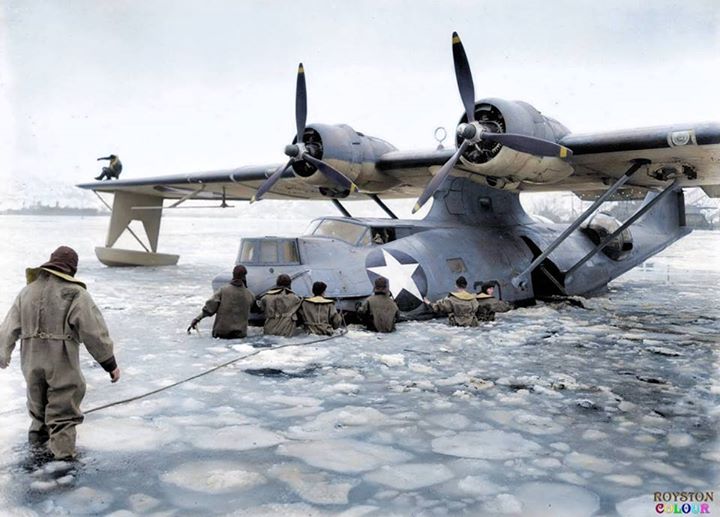
US Navy personnel freeing a PBY-5A ‘Catalina’ aircraft from frozen waters in the Aleutian Islands at Kodiak Bay, US Territory of Alaska, sometime during the period between June 1942 and January 1943.
The Aleutian Islands Campaign was a struggle over the Aleutian Islands, part of the Alaska Territory, in the American theatre and the Pacific theatre of World War II starting on the 3rd of June 1942. A small Japanese force occupied the islands of Attu and Kiska, but the remoteness of the islands and the difficulties of weather and terrain meant that it took nearly a year for a far larger U.S./Canadian force to eject them.
For the next nine months the Japanese were harassed from the sea, and from the air by USAAF bombers operating from air strips specially built on two other islands, Adak and Amchitka, just 145 km. (90 mi.) and 95 km. (60 mi.) respectively from Kiska. But adverse weather conditions hindered any real attrition of the occupying Japanese and it was not until March 1943 that sufficient Allied forces became available to drive them from American soil.
The weather made American air support unreliable as Rear-Admiral Charles McMorris discovered when it failed to arrive after he encountered Hosogaya’s more powerful force on the 26th of March 1943. However, the battle of the Komandorski Islands which followed prevented the 2,630-strong Japanese garrison on Attu from receiving any further infantry reinforcements before 11,000 men of the 7th US Infantry Division landed there on the 11th of May 1943 with the support of a battleship bombardment and, for the first time in the Pacific war, with air support supplied by an escort carrier. The Japanese, commanded by Colonel Yamazaki Yasuyo, resisted stubbornly and on the 16th of May the commanding US General was dismissed when he remarked that it would need six months to conquer the island.
But Yamazaki and his men, outnumbered and poorly supported from the air and sea, were gradually pushed into the last high ground. Then, before dawn on the 29th of May, they launched one of the biggest banzai charges of the war which overran two command posts and a medical station before being halted. The battle went on all day and the next morning the surviving Japanese made a final attack before most of the survivors committed suicide. Only 28 prisoners were taken and 2,351 bodies were counted. The Americans lost 600 killed and 1,200 wounded.
Vice-Admiral Thomas Kinkaid, who had succeeded Rear Admiral Theobald in January 1943, now turned his attention to Kiska. He imposed a destroyer blockade and ordered intensified air and sea attacks on the garrison. However, by then the Japanese had decided to evacuate the island and on the night of 28/29th of July, while US naval patrol ships were refuelling after the ‘Battle of the Pips’, the Japanese Navy expertly evacuated 5,183 troops and civilians under cover of fog. Air reconnaissance failed to establish that Kiska was no longer occupied and as ground fire was reported on several occasions it was suspected that the Japanese might be hiding. So on the 15th of August 1943 a force of 34,000 US and Canadian troops landed, but it took them some days to discover the Japanese had departed. In doing so 56 men were killed or wounded when friendly patrols fired on one another.
(Colourised by Royston Leonard UK)
https://www.facebook.com/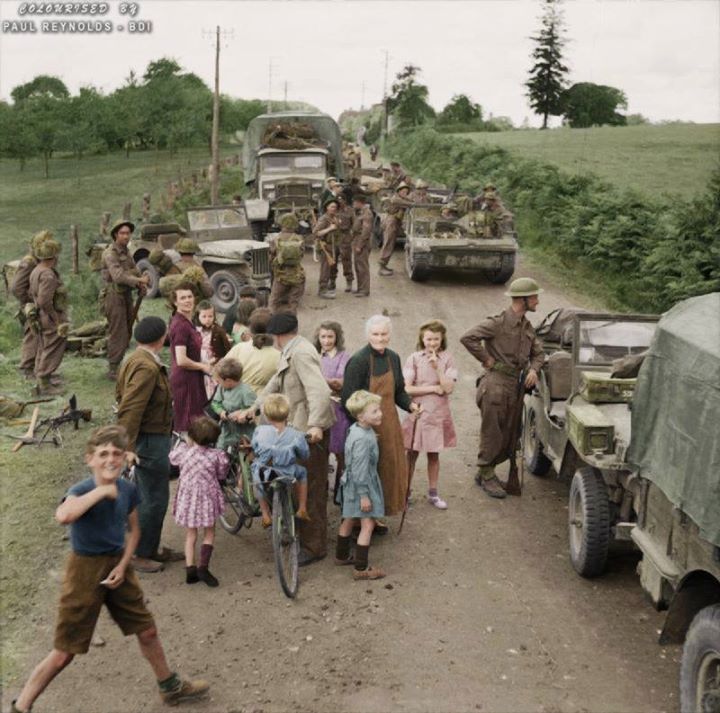
Local villagers come out to meet a British column of trucks, jeeps and carriers on a road near Flers, north-western France.
17th of August 1944.
(Source – © IWM B 9333
Sgt. Laing of No 5 Army Film & Photographic Unit)
Officers Diary from the Field Battery, 86th (East Anglian)(Hertfordshire Yeomanry) R.A.
Aug 17th ’44
“Our 2 days rest lasts exactly 20 hrs. We join the 11th Armoured Div: to chase the enemy in the Falaise Gap. Recce parties moved at 1300 hrs to recce the route to FLERS as the bridge at CONDE is not yet completed. The C.O.24 runs over a mine and is severely wounded in the leg. The recce party makes a long detour held up by mines and blown bridges. After a 4 hr journey the Recce arrives in FLERS to see the tail of the Regt disappearing east out of the town. The bridge at CONDE has been opened and the Regt has come the quickest way. The guns are in action laid out by compass before the recce party catches up.”
“In FLERS we have our first taste of liberation and understand something of what we have been fighting for. All the tiredness and fatigue, all the casualties we have suffered seem worth while when we see the ecstasy and pure joy on the faces of the French people newly liberated from the enemy. Old & young men women & children are waving flags & shouting & singing, all struggle to shake the hand of Tommy. The strain of the fighting drops from our minds & bodies. Moral goes up 200% and we throw away our sweets & cigs ……”
(Colourised by Paul Reynolds.)
https://www.facebook.com/
Historic Military Photo Colourisations 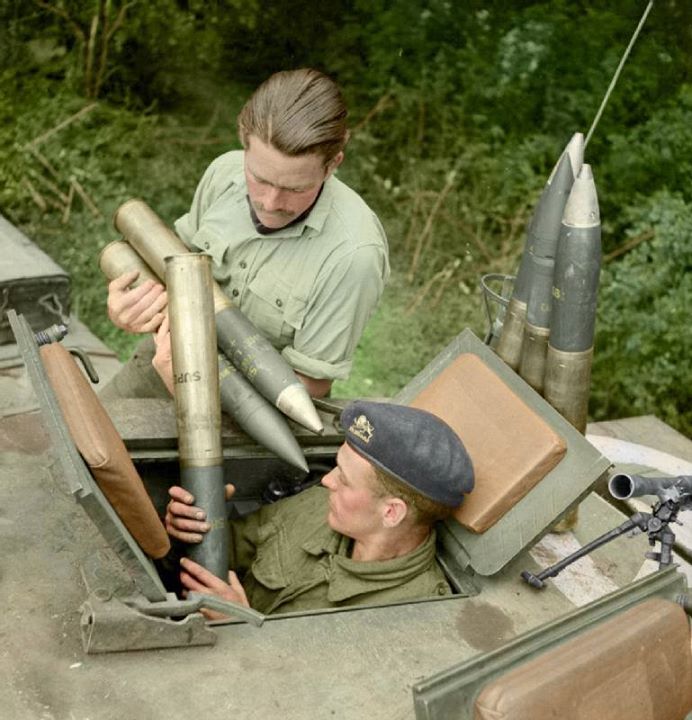
Lt. J. Fathergill, CO of ‘B’ Squadron, 107th Regiment Royal Armoured Corps, 34th Tank Brigade, assists his gunner loading 75mm ammunition into the turret of his Churchill tank in Normandy. 17th of July 1944.
At the beginning of July 1944, 107 RAC embarked at Gosport for Normandy with 34th Tank Brigade. As an independent brigade under 21st Army Group, it could be assigned to support any infantry division that required the assistance of tanks, its regiments usually split up to form brigade groups with the infantry.
107 RAC went into action on 15 July during Operation Greenline, part of the Second Battle of the Odon designed to pin German forces so that they could not interfere with the planned breakout from the Normandy beachhead. The regiment supported 15th (Scottish) Division in a night attack towards Evreux. 107 RAC’s War Diary records that ‘the attack from the inf. point of view was a complete success’, but complains that the regiment’s tanks were blinded by the ‘excellent’ smoke laid down by the artillery and infantry, and were late withdrawing the following day. The regiment had lost six tanks, with six men killed, seven wounded, and one missing.
On 22 July 107 RAC supported troops of 53rd (Welsh) Division in a raid, and then went to support 59th (Staffordshire) Division in case of counter-attack.
(Nb. Page Follower, Chris Morriss added that Lt. J. Fathergill was killed on the 14th of August 1944, less than a month after this photo, and is buried in BANNEVILLE-LA-CAMPAGNE WAR CEMETERY about 10km from Caen. – R.I.P. Lt John Fothergill. We Will Remember Them.)
(Photo Source – © IWM B 7619)
(Colourised by Joshua Barrett from the UK)
https://www.facebook.com/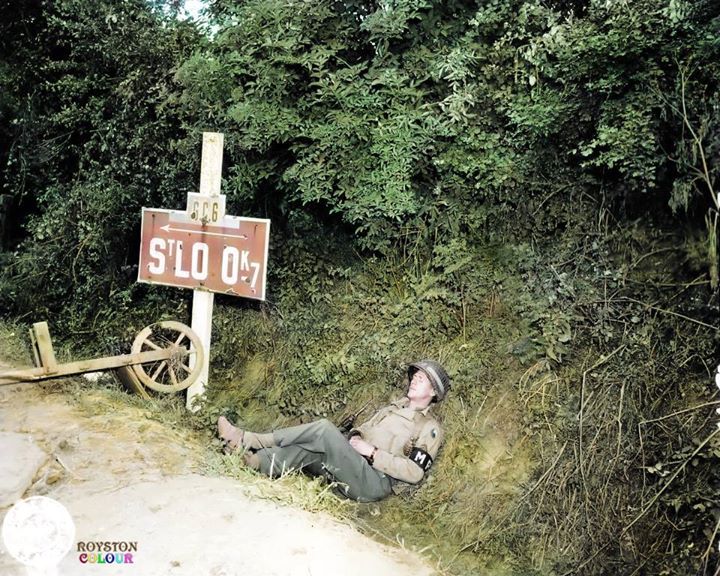
(Colourised by Royston Leonard from the UK)
https://www.facebook.com/
This famous photograph by war correspondent Gordon Short captures Leslie ‘Bull’ Allen rescuing a wounded American soldier on Mount Tambu, New Guinea, 30th of July 1943.
(Source: Australian War Memorial, image number 015515)
During an American assault against the Japanese on Mount Tambu, more than 50 US soldiers were injured. Two medics were killed trying to retrieve them.
The Australians were not supposed to be involved in the fighting, but having witnessed so many casualties, Allen, a stretcher-bearer, was determined to do what he could.
The Australian War Memorial record for the photograph states:
“1943-07-30. Mount Tambu, New Guinea. 2/5th Battalion stretcher bearer Corporal Leslie ‘Bull’ Allen MM, age 26, of Ballarat, Victoria, carrying to safety an American soldier who had been knocked unconscious by a mortar bomb. Allen carried out twelve American casualties while under fire on Mount Tambu. For this gallantry he received the United States Silver Star. He had won his Military Medal as a Private on 7 February 1943 at Crystal Creek, Wau.”
A Ballarat filmmaker who researched Allen’s story, Lucinda Horrocks, says what the soldier did next was extraordinary.
“So this is the point at which Bull decides to go up and start carrying men out one at a time over his shoulder, through this terrain, facing the snipers and the machine gun fire and the mortar fire,” she said.
Amateur historian David Cranage says each time he went back for another rescue attempt, soldiers would make bets on whether he would return.
“Backwards and forwards, backwards and forwards. Magnificent courage, unbelievable,” he said.
“I’ve never heard anything like it before in my life and I’ve spent many years studying military history.
“Remember, he was carrying men from another country.
“His heart was so big. He just hopped in. It wouldn’t matter where you came from. That’s the mark of the man.”
It was an act of bravery worthy of place in Australian folklore.
Now, 70 years after the bloody Wau-Salamaua campaign fought in Papua New Guinea, historians are calling for the military’s highest honour, the Victoria Cross, to be posthumously bestowed on Australian war hero Leslie ‘Bull’ Allen.
Link to the full story here: http://www.abc.net.au/
(Colourised by Allan White from Australia) 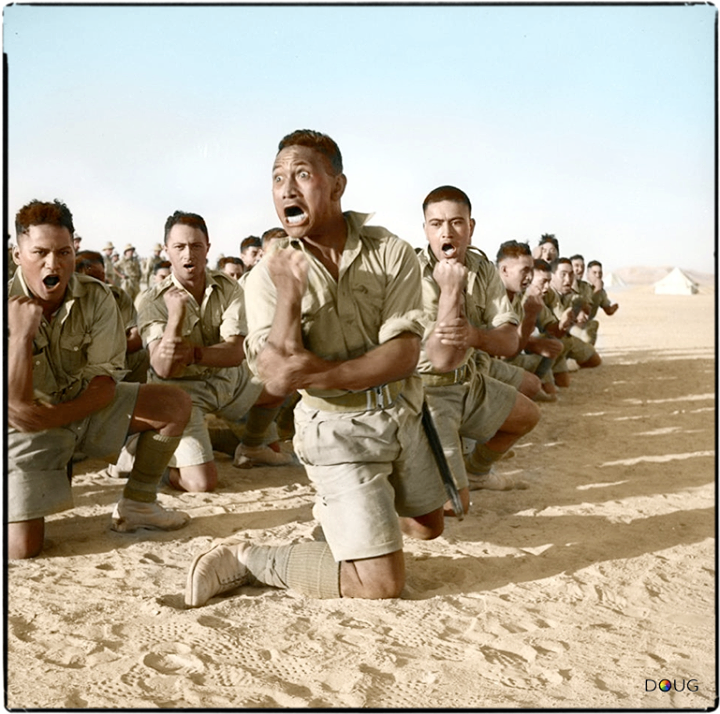
Māoris of ‘C’ Company, 28th Māori Battalion of the 2nd New Zealand Division perform the ‘Haka’ (ancestral war dance) for the visit of King George II of Greece, his wife the Queen, his cousin Prince Peter and Major General Freyberg.
At an army training camp at Helwan in Egypt.
In the early evening of the 25th of June 1941.
(© IWM E 3261E)
The four men in the foreground are, l to r: John Manuel (from Rangitukia, KIA 15/12/41), Maaka (Bill) White (Wharekāhika, KIA 23/11/41), Te Kooti (Scotty) Reihana (Rangitukia, WIA), Rangi Henderson (Te Araroa, KIA 26/3/43).
King George of Greece was visiting the New Zealand troops that had assisted he and his family in escaping from Crete, the previous month. (see ’42nd Street’ below).
‘The Battle of 42nd Street’ – a line running south from Suda Bay to the foothills of the Malaxa escarpment.
On the morning of the 27th of May the Australians and New Zealanders formed the rearguard of the Commonwealth force retreating southward toward the evacuation beaches at Sfakia. The troops on ’42nd Street’ looked out from the cover of an earth bank through closely planted olive groves toward a creek, which the desert-wise Australians called a “wadi”. Their commanding officers conferred, agreeing that if the Germans came close they would attempt a counter-attack.
As the Germans approached, two of the 2/7th’s companies suddenly charged, shouting and firing, taking the Germans in their flank. New Zealanders of the 28th (Maori) Battalion quickly joined in the attack. Startled by men erupting from dense cover, the Germans ran before the Australians.
The charge at ’42nd Street’ stopped the 5th Alpine Division (5.Gebirgsjäger-Division) for the rest of the day: 200 Germans and four Australians died on the 2/8th’s front, with the Maoris estimating that they had killed another 80 Germans. That afternoon, though, ’42nd Street’s’ defenders saw mountain troops moving across the foothills of the escarpment. Staying would lead to encirclement and the defenders withdrew to join the columns trudging south. Five days later, after the tortuous retreat through the White Mountains, the 2/7th reluctantly surrendered on the cliffs above Sfakia.
4.Fallschirmjäger Division, at Anzio in Italy, January 1944
The trooper shows off a captured British ‘Bren’ Light Machine Gun and is leaning on a wooden case marked: “Luftdichter Patronenkasten” (Air tight sealed ammunition boxes, for 1500 x 7.92 Mauser or 9mm cartridges).
(source: Bundesarchiv Bild 101I-576-1846-11A)
The 4 Fallschirmjäger Division was formed in Venice, Italy, in November 1943, from elements of 2 Fallschirmjäger Division and volunteers from the Italian 184 and 185 Airborne Division Folgore parachute divisions.
Its first combat action was against the Allied landings at Anzio (Operation Shingle) as part of the I. Fallschirm Korps in January 1944.
After Anzio, the Division fought a rear guard action in front of Rome, and was the last German unit to leave the city on 4 June; it withdrew towards Viterbo Siena Firenze and then managed to halt the Allies at the Futa pass.
In the Winter of 1944/1945 it was positioned on the Gothic Line. In March 1945, the Division had to send the II Battalion, 12 Fallschirmjäger Regiment and the 2nd Company from the Pionier Battalion to the new 10 Fallschirmjager Division, which was being formed in Austria.
It surrendered to the Allies in April 1945.
(Colourised by Doug)
http://
A comrade nails a division sleeve badge on the grave of Cpl. Marcelino Gil Martin of the 2nd Battalion, 263 Inf. Regt., 250th ‘Division Azul’ Wehrmacht Spanish Volunteers (Died 22/8/42) in Grigorovo, Near Novgorod in Russia.
This photo was taken in June 1943 when his brother, Lt. Angel Eustaquio Gil Martin obtained the necessary permission to go to the Volkhov Front to look for the grave of his brother Marcelino, who fell the previous year.
Close port-side view of a CAC CA-13 Boomerang fighter aircraft, serial no. A46-128, of No. 5 (Tactical Reconnaissance) Squadron RAAF, piloted by 407056 Flight Lieutenant Donald Howard Goode of Port Pirie, South Australia.
The aircraft is coded BF-N with the nicknamed “U-Beaut 2” and is flying from Mareeba, Queensland.
18th of March 1944.
(Australian War Memorial image NEA0414)
No. 4 Squadron and No. 5 Squadron flew Boomerangs in New Guinea, the Solomon Islands Campaign and Borneo Campaign, also in the close support role, with marked success. Flying in pairs (one to observe the ground, the other to observe the air around them), their tasks included bombing, strafing, close infantry support and artillery spotting. When attacking larger enemy formations Boomerangs often operated in conjunction with larger aircraft. In this role the Boomerang would get in close to confirm the identity of the target and mark it with a 20 lb (9 kg) smoke bomb with the “cooperating” aircraft delivering the major ordnance from a safer distance. A partnership between 5 Sqn Boomerangs and Royal New Zealand Air Force Corsair fighter bombers during the Bougainville Campaign was said to be particularly effective.
(Colourised by Doug) 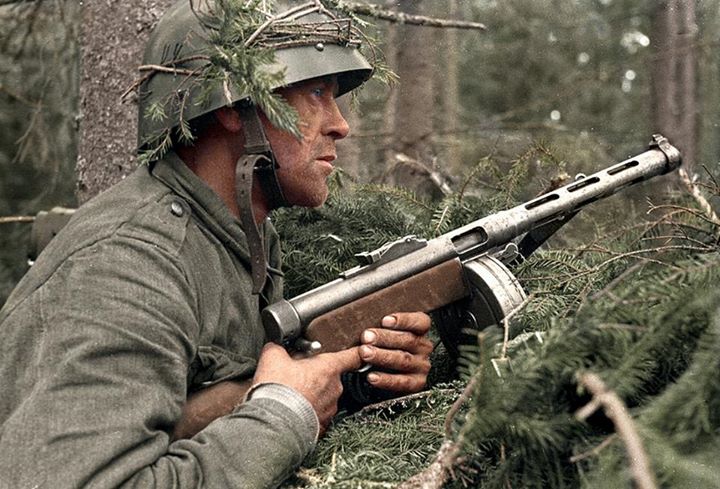
July 1944.
(Note he wears a Czechoslovakia Vz32/34 helmet)
(Colourised by Jared Enos from America)
https://www.facebook.com/
Generals Dwight Eisenhower and Omar Bradley share a laugh as they leave General Ira Wyche’s 79th Division headquarters in Huanville, Normandy, France, July 4, 1944.
(US National Archives)
(Colorized by Mads Madsen form Denmark)
https://www.facebook.com/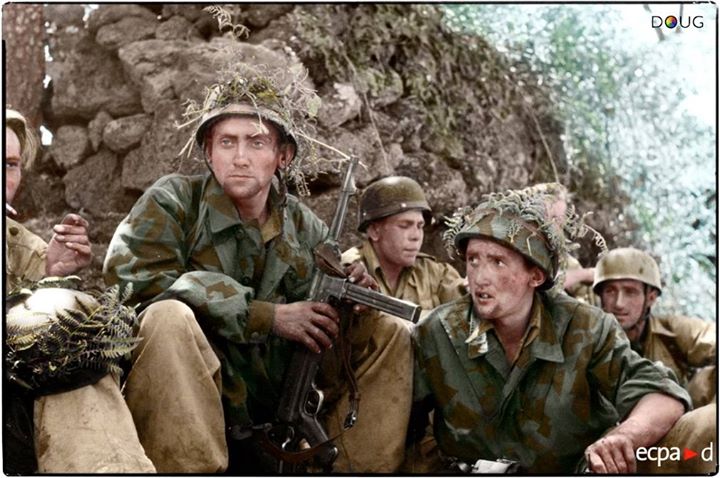
Fallschirmjäger Regiment 3. in Sicily August 1943.
The Battle of Centuripe was fought from the 2 to 4 August 1943, as part of the Allied invasion of Sicily during World War II. Forces of the British Eighth Army, engaged in fierce fighting around the town of Centuripe in the central portion of Sicily in the hill country between the Rivers Dittaìno and Salso. The battle focused around Centuripe which the German Wehrmacht had heavily fortified the hill town set on a very high rocky pinnacle and approached by only one steep and twisty road. Centuripe itself was the key to the whole Adrano position and the capture of Adrano would in turn force the Germans to withdraw to new positions. The British troops captured the town after heavy fighting and as a result caused the Germans to start contemplating abandoning Sicily altogether.
The key position in the German defence line across Sicily was Centuripe, a village perched on the top of a formidable line of steep hills along with its precipitous sides which gave it an almost impregnable position. The lesser hills round it were well defended by the Germans and it was necessary for them to be mastered before Centuripe could be tackled. Defending this position was the crack Hermann Göring Division comprising mostly of the 3rd Fallschirmjäger regiment as part of Kampfgruppe von Carnap under Ludwig Heilmann. As well as the regiment, the kampfgrugge consisted of an artillery regiment and a number of reconnaissance units which included a number of tanks with supporting infantry units. Heilmann had replaced the commander Oberstleutenant Von Carnap after he had been killed by British artillery fire in late July.
(ECPAD ref. F1465)
A pilot of No. 175 Squadron RAF scrambles to his waiting Hawker Typhoon Mark IB at B5 Airstrip Le Fresne-Camilly, Calvados, France following a call from the Group Control Centre ordering an air strike.
24th July 1944.
(© IWM CL 570)
The airstrip was built under German fire between 10th – 17th June 1944 and was home to the Hawker Typhoons of 121 Wing, Royal Air Force.
4./ Fallschirmjäger-Division at Nettuno, Italy. (late 1943-early 1944)
The 4./Fallschirmjäger-Division was formed in Venice, Italy, in November 1943 from elements of 2. Fallschirmjäger-Division with the addition of volunteers from the Italian parachute divisions 184. Parachutist Division Nembo and 185. Parachutist Division Folgore.
It was sent into action against the Allied landings at Anzio (Operation Shingle) as part of I. Fallschirm-Korps in January 1944. It fought the Allied forces in Italy until the surrender in May 1945 in the area between Viacenza and Bozen.
(Source- Bundesarchiv Bild 101I-575-1822-30A)
“Tuskegee” airman Edward Creston Gleed from Lawrence, Kansas, Class 42-K, with two unidentified crewmen adjusting an external seventy-five gallon drop tank on the wing of a P-51/D Mustang, “Creamer’s Dream” (generally flown by 1st.Lt.Charles White) 301st FS, 332nd Fighter Group air base in Ramitelli, Italy, March 1945.
The title “Tuskegee Airmen” refers to all who trained in the groundbreaking Army Air Forces African-American pilot training program at Moton Field and Tuskegee Army Airfield, Alabama between 1941 and 1945. It includes pilots, navigators, bombardiers, maintenance and support staff, instructors and all the personnel who kept the planes in the air.
(Photograph by Toni Frissell)
(Colorised by Sanna Dullaway from Sweden) https://www.facebook.com/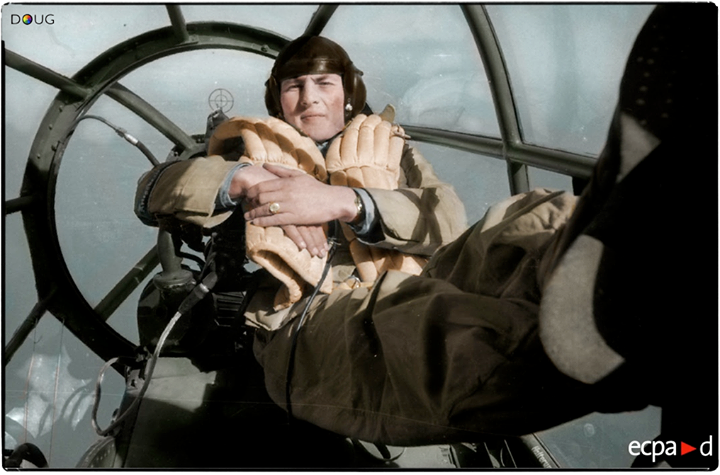
(Sourse: Ecpad)
(Colourised by Doug)
